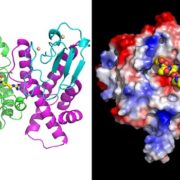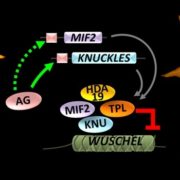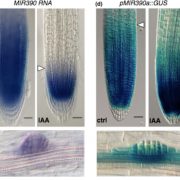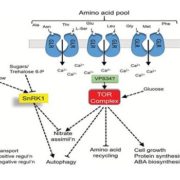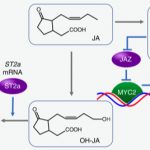Integration of light signaling with endogenous developmental pathway to regulate flowering (Mol. Plant)
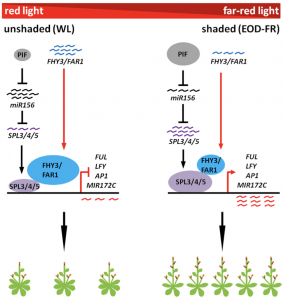 Response to changing environmental conditions is key for plant reproductive success. Previous studies have implicated FAR-RED ELONGATED HYPOCOTYL3 (FHY3) and FAR-RED IMPAIRED RESPONSE1 (FAR1) as inhibitors of flowering in phytochrome A signaling pathway. miR156-targeted SQUAMOSA PROMOTER BINDING PROTEIN LIKE (SPL) genes are involved in transition from juvenile to adult phase and promote flowering. In this paper Xie et al., showed that FHY3 and FAR1 protein levels decrease and that of SPL3/4/5 protein levels increase in response to shade, promoting flowering. Using biochemical and molecular genetic experiments they have shown that increased levels of SPLs activate the downstream target genes (FRUITFUL, LEAFY, APETALA1, MIR172C) by direct binding to the cis-regulatory elements in their promoters. The authors also show that under normal light conditions FHY3 and FAR1 interfere with SPLs by protein-protein interaction and this interaction weakens in shade, activating the downstream genes responsible for flowering. (Summary by Vijaya Batthula) Mol. Plant 10.1016/j.molp.2020.01.013
Response to changing environmental conditions is key for plant reproductive success. Previous studies have implicated FAR-RED ELONGATED HYPOCOTYL3 (FHY3) and FAR-RED IMPAIRED RESPONSE1 (FAR1) as inhibitors of flowering in phytochrome A signaling pathway. miR156-targeted SQUAMOSA PROMOTER BINDING PROTEIN LIKE (SPL) genes are involved in transition from juvenile to adult phase and promote flowering. In this paper Xie et al., showed that FHY3 and FAR1 protein levels decrease and that of SPL3/4/5 protein levels increase in response to shade, promoting flowering. Using biochemical and molecular genetic experiments they have shown that increased levels of SPLs activate the downstream target genes (FRUITFUL, LEAFY, APETALA1, MIR172C) by direct binding to the cis-regulatory elements in their promoters. The authors also show that under normal light conditions FHY3 and FAR1 interfere with SPLs by protein-protein interaction and this interaction weakens in shade, activating the downstream genes responsible for flowering. (Summary by Vijaya Batthula) Mol. Plant 10.1016/j.molp.2020.01.013



